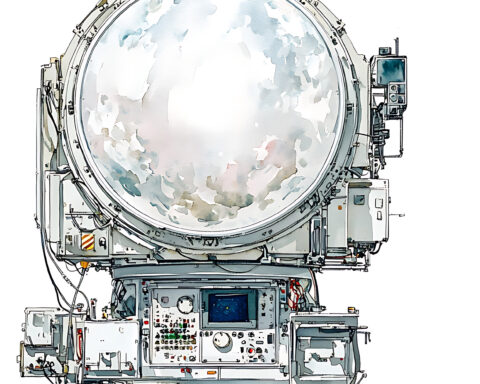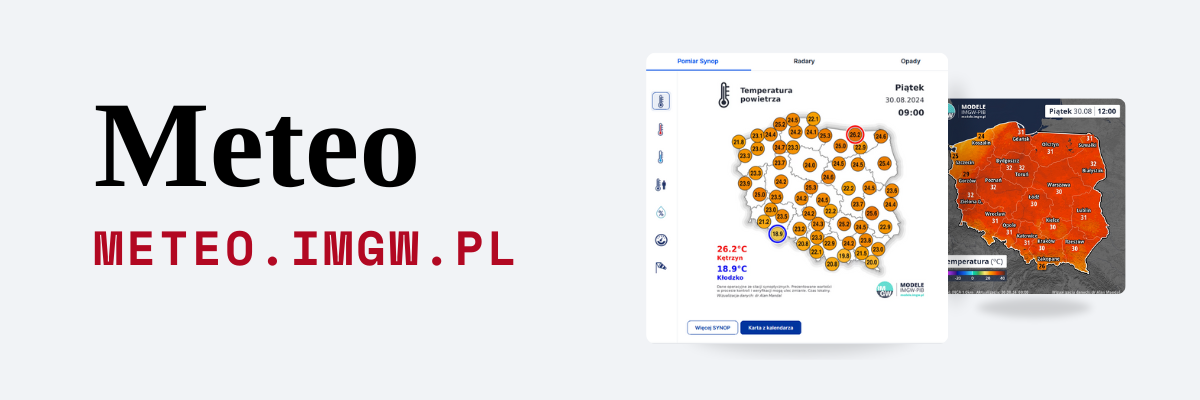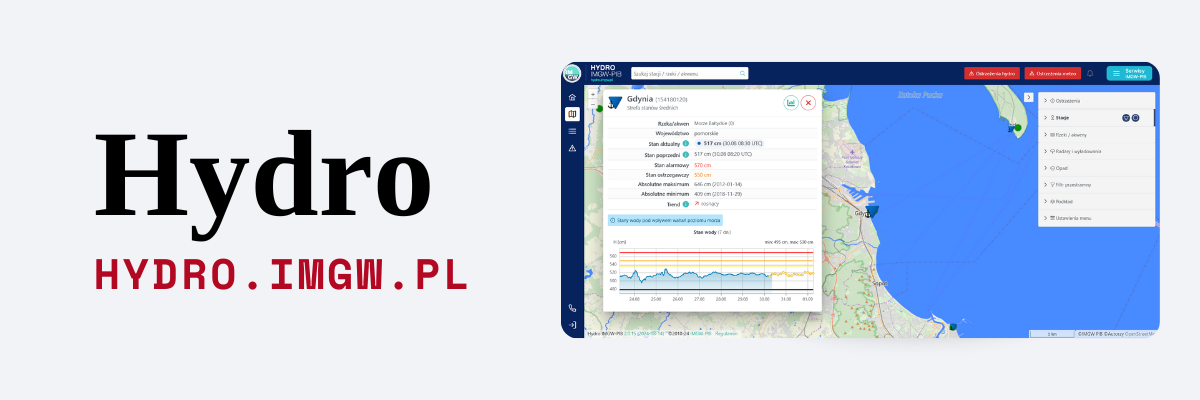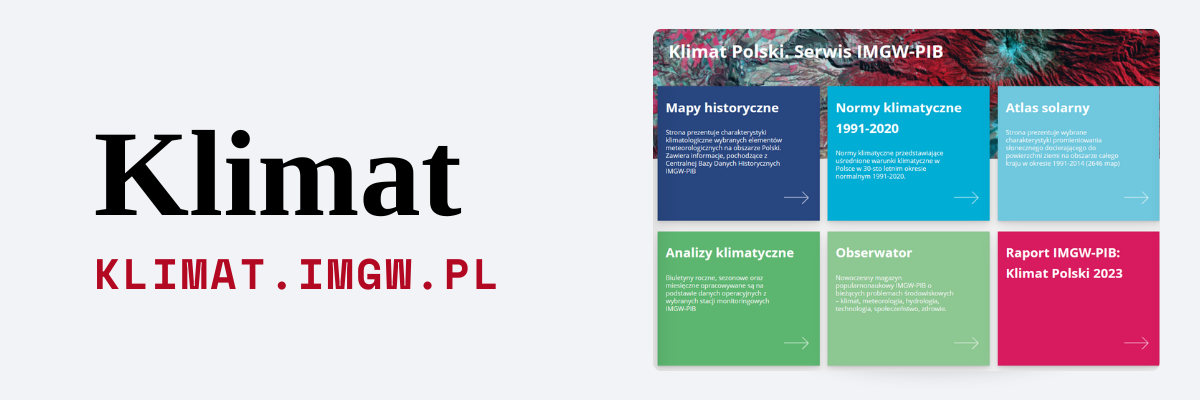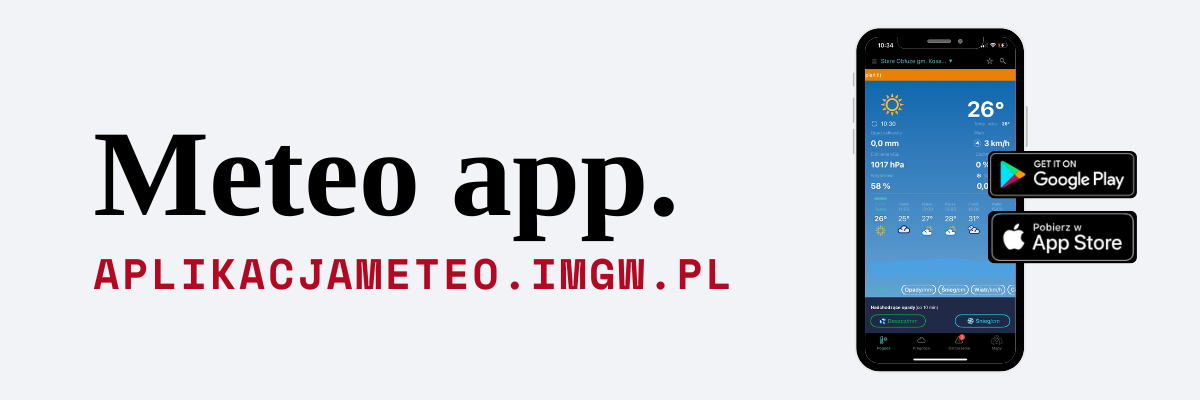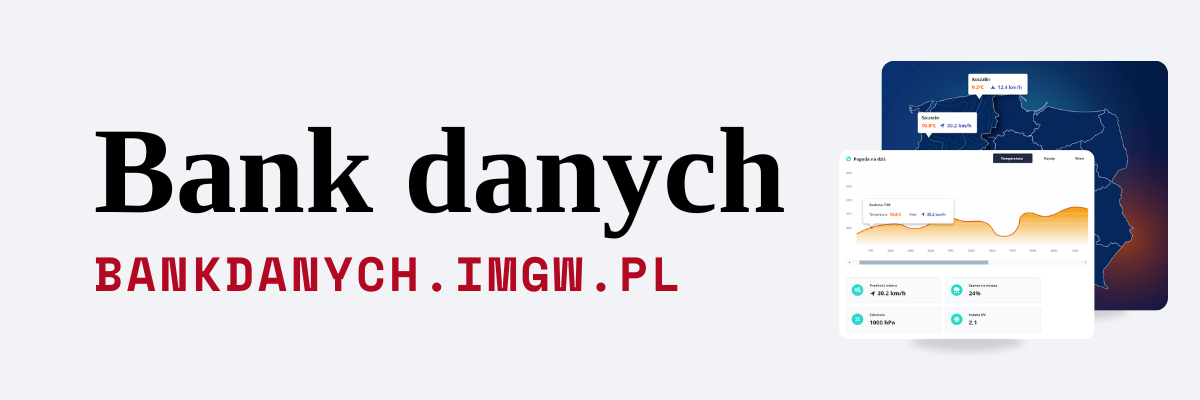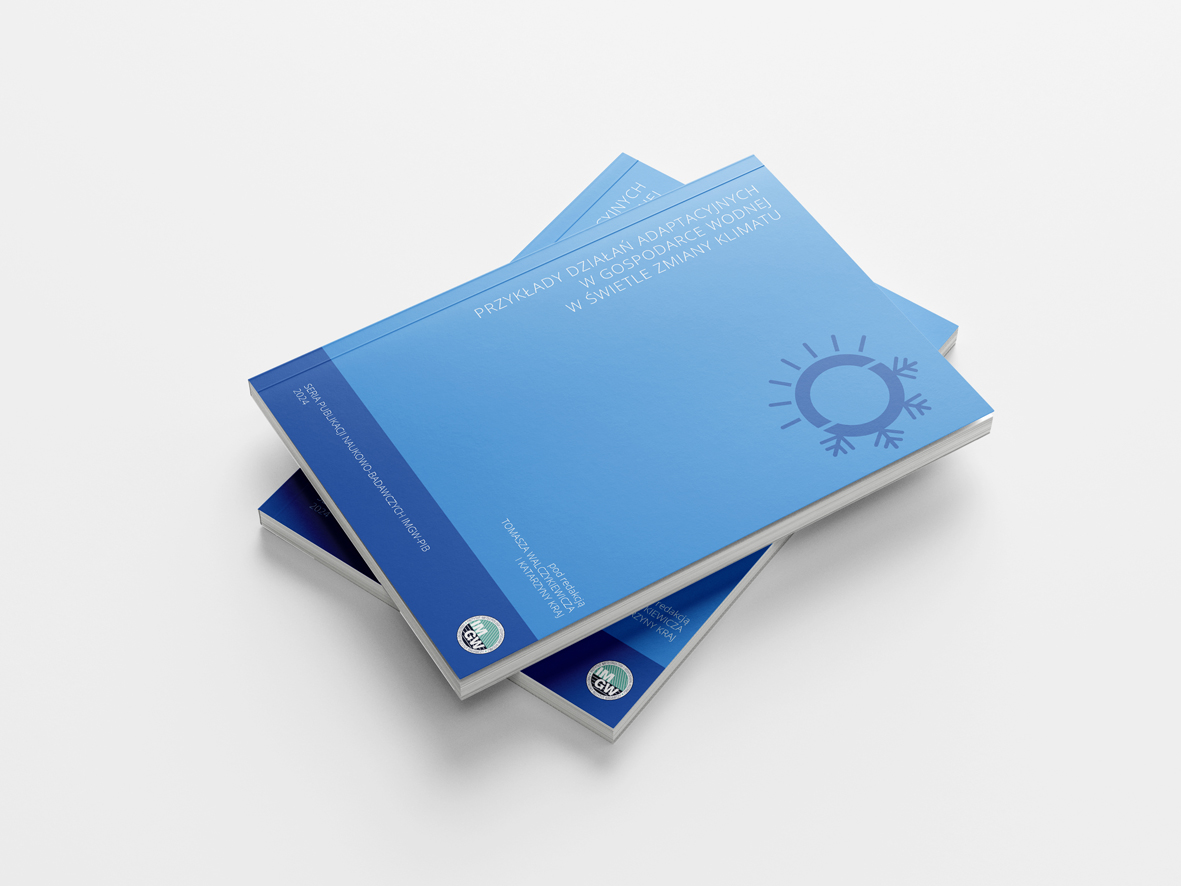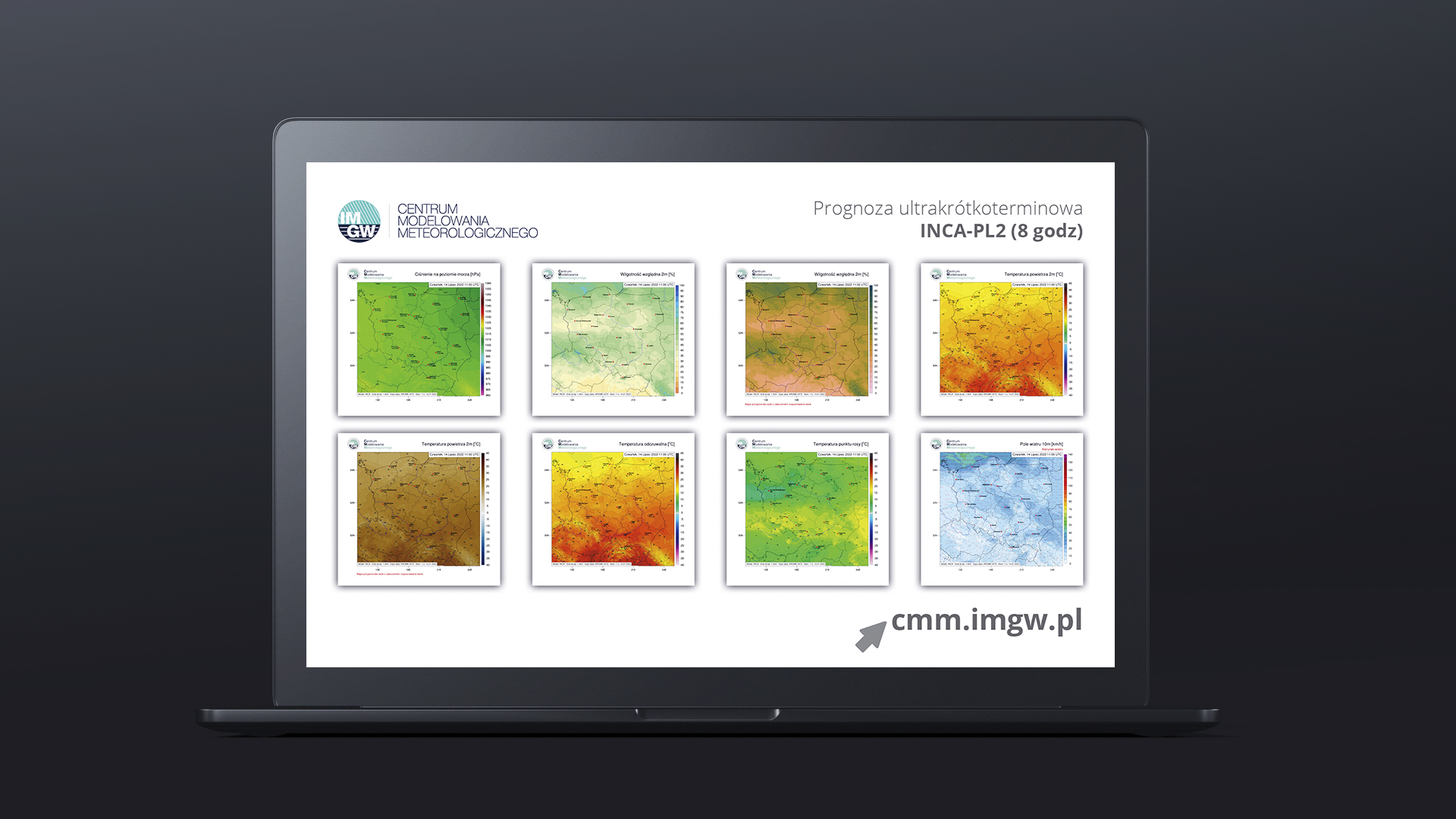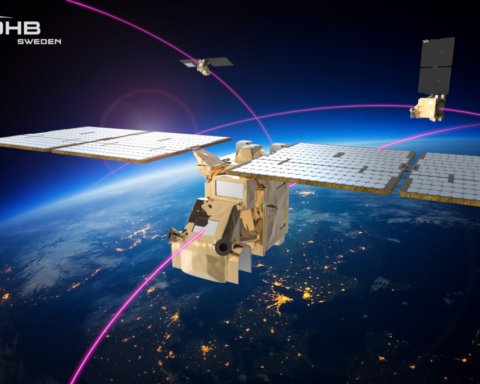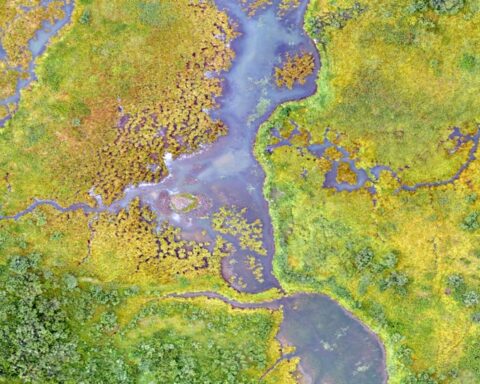In the 90s of the 20th century, some fundamental changes concerning the concept of development and application of weather forecasting methods at IMGW-PIB took place. In the face of these challenges, the Institute made a titanic effort. Thanks to its employees’ commitment, knowledge, and experience, within only one decade, it became a fully-fledged member of the international community of weather modellers.
AUTHORS:
Andrzej Wyszogrodzki, IMGW-PIB
Jan Parfiniewicz, IMGW-PIB
Andrzej Mazur, IMGW-PIB
Michał Ziemiański, IMGW-PIB
Grzegorz Duniec, IMGW-PIB
Witold Interewicz, IMGW-PIB
Marek Lazanowicz, IMGW-PIB
Joanna Linkowska, IMGW-PIB
Zbigniew Piotrowski, IMGW-PIB
Bogdan Rosa, IMGW-PIB
Damian Wójcik, IMGW-PIB
Adam Jaczewski, IMGW-PIB
The internal effort of IMGW-PIB experts carried out over the years were crowned with the launch in 1994 of the RADMET model, which was a tool for interpreting large-scale numerical forecasts available through the GTS network. An independent team worked on implementation of this system, consisting of: Jan Parfiniewicz, Andrzej Kadłubowski, Leszek Herman-Iżycki, Marek Lazanowicz and Andrzej Chmielewski. RADMET was adapted to the PC computers available at that time and could not compete with other forecasting models developed in leading European centres, such as the British Met Office, Météo-France, or DWD in Germany.
With the launch of the Cray Y-MP/EL98 supercomputer at the UW Interdisciplinary Centre for Mathematical and Computer Modelling (ICM) (1993/1994), a decision was made to apply a modern local model to this system. For this purpose the Met Office model was chosen. The task was carried out by Bogumił Jakubiak (then head of the Long-term Forecasting Department) and Leszek Herman-Iżycki. At the same time, in Krakow, a team led by Marek Jerczyński started implementing the French local model (ARPEGE/ ALADIN), which was computed in the Cyfronet supercomputer centre. As a result of the lack of a bilateral agreement between IMGW and the Met Office (one of the reasons was high license costs), the UK-Met model was taken over by ICM in 1997, where it has been used until now.
SMOK and consortia of numerical weather prediction models. As a result of the flood of the century in 1997, IMGW found itself in a critical situation of a shortage of reliable forecasting models that could effectively counteract similar natural disasters in the future. As a result, in 1999, as part of the new SMOK project (Country Monitoring and Protection System) co-financed by the World Bank funds, the implementation of a new generation non-hydrostatic model was planned. At that time, i.e., at the end of the 1990s, several international consortia developing weather prediction models were established in Europe, e.g., HIRLAM, ALADIN, and UKMO. These consortia exchanged experiences at the Short Range Numerical Weather Prediction (SRNWP) meetings held under the EUMETNET agenda.
During the SRNWP symposium in Offenbach (25-27 October 1999), attended by Jan Parfiniewicz and Leszek Herman-Iżycki (already representing ICM at that time), contact was made with Detlev Majewski, head of the numerical weather modelling team at DWD. The German organisation was then interested in expanding its own NWP(numerical weather prediction) consortium and agreed for IMGW’s access to the products of the GME global model and the high-resolution forecasting model (HRM/DWD) coupled with the Institute’s telecommunications node. This system was implemented at the IMGW by Jan Parfiniewicz, Marek Lazanowicz and Jan Orłowski. The graphic package GrADS (Brazilian version, in Portuguese) was also delivered, which enabled decoding the HRM model results received in GRIB format and obtaining (for the possibilities at that time) high-quality graphic products.
In 2000, during Majewski’s visit to Poland, a bilateral agreement between DWD and IMGW was signed – „Agreement on the delivery/release of simulation software development at the DWD for scientific/operational duty purposes, 21 March 2000”. At the same time, work was carried out under the SMOK project, consisting of installing a new supercomputer (SGI 3800) and implementing the numerical mesoscale forecasting model LM. This model was launched in the autumn of 2001, and in 2002 it was introduced into operational work at IMGW-PIB.
IMGW-PIB – a member of COSMO. The consortium referred to as COSMO was formally established in 1999 – a memorandum on international scientific cooperation on non-hydrostatic modelling was signed in March that year by the directors of the national meteorological services: MeteoSwiss (Switzerland), UGM/ARPA-SIM (Italy), HNMS (Greece) and DWD (Germany). The final agreement regulating the cooperation as well as the internal and external relations of the consortium was signed in the spring of 2001.
The general goal of COSMO is to develop, improve and maintain a high-resolution non-hydrostatic meteorological forecasting model used both for operational and research applications by consortium member countries. It was initially based on the DWD’s Lokal-Modell (LM) with an appropriate data assimilation system. The consortium partners are committed to actively contributing to the development of the model by providing human resources and participating in research collaboration. Each partner is required to be active at a minimum of two full-time positions in research and development.
From the beginning, COSMO was open to cooperation with other teams developing weather forecast models, research institutes, and universities and for accessing new members. Taking advantage of this opportunity, in September 2000, the IMGW submitted a formal application for membership. The declaration signing ceremony, which took place on 4 July 2002, was attended by representatives of COSMO member institutions: Massimo Capaldo, Chairman of the Steering Committee and Deputy Director of the Italian Central Meteorological Office (UGM), Udo Gärtner, President of the German Weather Service (Deutscher Wetterdienst, DWD), Gerhard Adrian, Head of DWD Research and Development Department, Chryssoula Gagaoudaki, Deputy Director of the Hellenic National Meteorological Service (HNMS), and Georges Sakellarides, Head of HNMS Research and Development Department. From the Polish side, Jan Calak was the representative of the National Committee for Scientific Research. The team responsible for cooperation within the consortium in the first years of its membership comprised Jan Parfiniewicz, Zbigniew Sorbjan, Witold Interewicz, Marek Lazanowicz, Katarzyna Starosta, Błażej Krzemiński, Joanna Linkowska, Jerzy Achimowicz and Andrzej Mazur. In later years, the consortium continued to develop intensively on the international arena, and other countries joined its structures: Russia, Romania and Israel.
Work within consortium structures. IMGW-PIB employees are obliged to actively support consortium activities both in ongoing scientific research projects and in formal organisational structures, such as working groups (WG) and steering committee (STC). Delegated IMGW employees, in particular COSMO Department, represented the Institute in STC structures: Ryszard Klejnowski/Jan Parfiniewicz/Andrzej Mazur/Zbigniew Sorbjan (until 2006), Michał Ziemiański/Andrzej Mazur (2007-2011), Rafał Bąkowski/Andrzej Mazur (2012-2013), Andrzej Wyszogrodzki/Andrzej Mazur (since 2014).
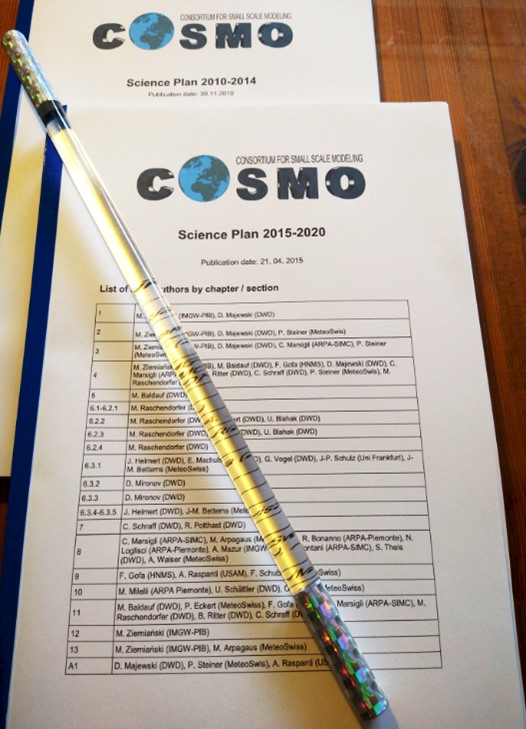
During the COSMO General Meeting in Rome in September 2011, Michał Ziemiański received from Detlev Majewski of the DWD a „magic wand” (transparent, plastic, with metal tips) as a sign of taking over the duties of a scientific project manager (SPM) in the years 2012-2016. The scientific project manager is the operational head of the consortium, responsible for supervising and coordinating the implementation of all scientific projects, overseeing the development of the model code, the work of working groups, the contribution of individual national organisations, and the development of new scientific and implementation plans. The period from 2012 to 2016 was particularly interesting in this respect, as a new scientific plan for 2015-2020 was developed, related to the target strategy of applying ensemble methods for short-term regional convective-scale weather forecasts. At the same time, the consortium was intensively developing new formal rules of its functioning, including the consortium agreement, rules of operation of internal consortium bodies, rules of model code development, and the introduction of internet tools to coordinate the ongoing work. Another significant aspect was the inclusion of a new member, Israel, in COSMO in 2017. So this period was both attractive as well as very intense.
In 2017, a representative of IMGW-PIB, Andrzej Wyszogrodzki, was elected for a two-year term as the Chairman of the Steering Committee. This function is associated with making key decisions regarding the consortium activities, including approval of new scientific projects (priority task, priority project) and organising general meetings of member countries (COSMO General Meetings). The Chairman is also responsible for approving proposals requiring the use of funds the consortium holds from the sale of licensing rights and services. A large part of these funds is allocated to support scientific activities by reimbursing conference trips and publication fees.
COSMO General Meetings in Poland. One of the commitments of the consortium member countries is the annual organisation and participation in COSMO General Meetings to exchange information on the progress of the projects prepared by the working groups, report the results, and plan the work for the following year. In addition to the Working Group Meetings (WG), a Steering Committee Meeting (STC) is also held. A summary of activities within projects and working groups are presented at plenary sessions. Member countries are jointly and severally liable for the cyclical organisation of meetings; of which the first was arranged in 1999 in Bologna, Italy.
The first COSMO General Meeting organised by IMGW (and the fourth in general) was held in Warsaw on 25-27 September 2002. It was a very stimulating meeting with many interesting presentations and discussions on a number of topics related to specific projects carried out within the framework of COSMO. The meeting was opened by Jan Zieliński, Director of IMGW together with Ryszard Klejnowski, IMGW Deputy Director for Forecasts. On the part of COSMO, the Chair of the Steering Committee, Massimo Capaldo, presented a description of the STC assigments. In turn, the Scientific Manager (SPM) Günther Doms (DWD) summarised the activities and projects carried out in the year preceding the General Meeting.
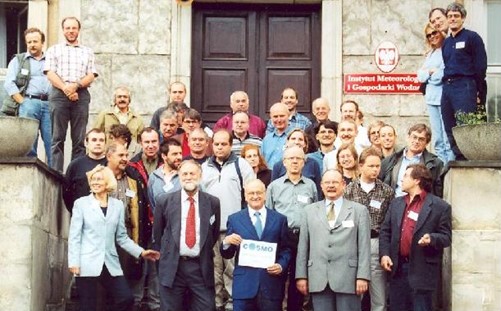
The tenth COSMO General Meeting was also held in Poland. The event that took place on 15-19 September 2008 in Krakow, reflected well the success of the development and application of the COSMO model and the fruitful cooperation within the consortium. Over the first 10 years, the meetings have evolved considerably: from a two-day meeting with a list of participants on a single sheet of paper to a full-week event with parallel sessions attended by up to 100 people. The general meetings organised in the member countries are also an opportunity to strengthen informal ties between the participants. For example, for many years, the female part of the consortium has chosen Mr. COSMO and has presented the winner with a special insignia. It is also an opportunity to learn about the culture and history of the region. For example, during the meeting in Krakow, participants visited the salt mine in Wieliczka.
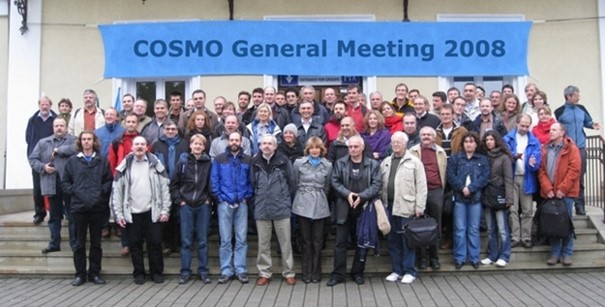
Seven years later, in 2015, the COSMO General Meeting was organised in Wroclaw. The event, which took place on 7-10 September, was attended by around 90 scientists, including for the first time a delegation from the country applying to the consortium – Israel. Conference participants had the opportunity to visit the Książ Castle near Wałbrzych.
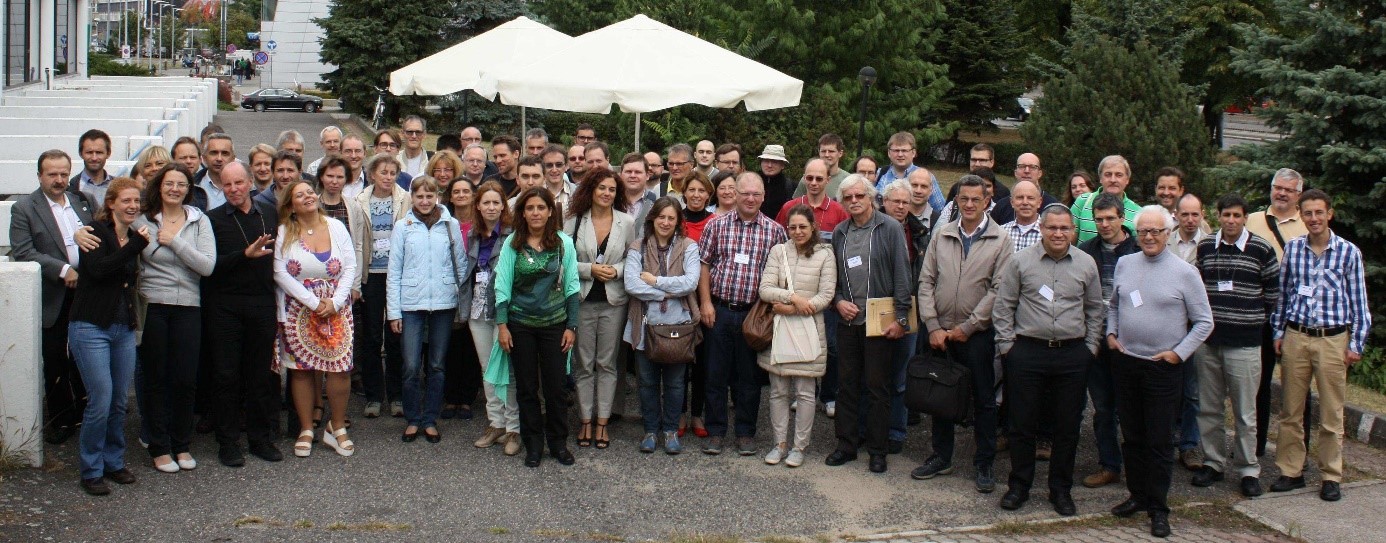
Milestones in the development of COSMO models at IMGW-PIB
Implementation and development of the measurement data assimilation system. One of the tasks of the CLIMATE project, carried out in 2008-2012, was called „Development of forecasting methods and warning systems against dangerous hydrological and meteorological phenomena and their use for country protection” and was coordinated by Michał Ziemiański. Its main assignment was to implementing the data assimilation system in the COSMO regional model into operational activities. The team working on this task consisted of: Andrzej Mazur, Witold Interewicz, Joanna Linkowska, Piotr Drzewiecki, Marek Lazanowicz, Grzegorz Duniec and Rafał Kielar.
This system is based on a cycle of data analysis and assimilation (CAAD) that enables the improvement of the quality of the analysis fields used for model initialisation and leads to a reduction of the forecast error in terms of statistical verification. The CAAD operation consists of cyclical execution (between the main terms of calculating the COSMO model forecast) of short, several-hour forecasting runs, taking into account local observational and measurement data. The first run is fed with the analysis field coming from the global model. Subsequent CAAD runs are already fed with the analysis fields from the previous short run of the regional model and take into account the latest observation data from the PILOT, TEMP, SYNOP, AMDAR, BUOY, and SHIP messages received from the GTS/WMO network.
In the COSMO model, a method called nudging is applied for data assimilation by introducing an additional module responsible for forcing (i.e. matching or literally bending the predicted values to the observational data) into the model equations. This element/module is appropriately dependent on the assimilated measurement data. The basic element enabling CAAD operation is the commercially purchased Sky-Globus system (developed by Basler + Partner GmbH), applied for acquisition and conversion of measurement data to BUFR format and then to NetCDF format, compatible with the COSMO model data assimilation system.
Construction of the new COSMO-EULAG dynamic core. In September 2008, during the COSMO General Meetings in Krakow, it was decided to start a new research programme to develop and implement a future dynamic core for the COSMO model. At the beginning of 2009, the corresponding priority consortium project, Conservative Dynamical Core (CDC), was launched. The project was strongly supported by a new IMGW team formed by young scientists from the Institute of Geophysics of the UW (University of Warsaw): Marcin Kurowski, Zbigniew Piotrowski, and Bogdan Rosa working with Michal Ziemiański. During Zbigniew Piotrowski’s long-term foreign research visit, the team was joined by Damian Wójcik, a graduate of physics and computer science at the UW. Marcin Kurowski, on the other hand, moved to the Jet Propulsion Laboratory in Pasadena after several years of working in the team.
The team was involved in implementing the research dynamic core EULAG in the COSMO model, developed at the National Center for Atmospheric Research (NCAR) in the USA by Piotr Smolarkiewicz, collaborating with Wojciech Grabowski, Andrzej Wyszogrodzki and many other scientists. The IMGW team benefited from the experience of the American partners through ongoing consultations, resulting in the anelastic version of EULAG being successfully introduced to the COSMO model at the turn of 2014 and 2015. The team also undertook work on adapting EULAG to new supercomputing architectures, including those based on graphics cards (GPU). Cooperation was established for this purpose with researchers from the Częstochowa University of Technology and the Poznan Supercomputing and Networking Centre (PSNC). Collaboration with MeteoSwiss, which at the time was pioneering a revolution in using such supercomputing architectures for the operational production of numerical forecasts, was also extended.
Meanwhile, Piotr Smolarkiewicz and his colleagues developed a new version of EULAG based on compressible equations of motion, and work on the practical application of this method to the weather model was undertaken by a team at ECMWF (European Centre for Medium-Range Forecasts) in Reading. After that, COSMO proposed to the IMGW team to implement compressible EULAG to the COSMO model and prepare a fully operational version of such a model. An interesting situation was then created when the introduction of a new type of dynamic core to numerical weather models was carried out by two parallel teams – one at ECMWF for global applications, and the other at IMGW, for regional forecasts – maintaining basic contact enabling the exchange of ideas and experiences.
The consortium’s task has been completed. Since 2020 the COSMO model with a compressible EULAG core has been working operationally at the IMGW-PIB. The Warsaw team proved that the EULAG compressible dynamic core has special properties that increase the accuracy of forecasts and ensure high numerical stability of calculations. It can also be applied in future operational weather models with very high resolution (even with a horizontal grid step of 100 m) over realistic orography, as well as for research work.
It is worth noting that the work carried out at IMGW-PIB on the implementation of EULAG into the COSMO model had a broader significance for the Institute: it allowed to extend and intensify scientific cooperation with world-class research centres. In addition, they impacted the scientific development of the Institute’s personnel (including the habilitation and doctorate degrees) and enabled IMGW-PIB to participate in external research projects. The continuation of these works should bring further scientific development and operational benefits to the Institute.
Further development of high-resolution regional models. Since 2015, the consortium has tried to replace COSMO with a new model that is a local version of the global ICON (ICOsahedral Non-hydrostatic) model working on a non-structured grid. Compared to COSMO, the main advantages of ICON-LAM (Local Area Model) are the flexible option for bi-directional grid nesting and the increased numerical stability of high horizontal resolution calculations in areas with steep topography. In the case of the high Alps, it means that the horizontal grid resolution can be increased well below 1 km. In the following years, decisive progress was made in improving the quality of ICON-LAM forecasts. The model was introduced to DWD operational activities in 2019 and made available in other COSMO member countries. A new partnership agreement between DWD and COSMO was signed in March 2020 to continue developing the ICON-LAM model. DWD represents in this agreement the institutions that originally developed the global version of the ICON model: the Deutscher Wetterdienst (DWD), the Karlsruhe Institute of Technology (KIT), the Max Planck Institute for Meteorology (MPI-M), and the Deutsches Klimarechenzentrum (DKRZ) in Hamburg. Under the agreement, COSMO member countries were granted the right to non-exclusive, free, and unlimited use of the ICON model for non-commercial research and development and statutory tasks.
In November 2021, the last official version of the COSMO model (v6.0) was prepared and made available, containing all algorithms and parameterisations developed so far. This version will remain frozen, with only bug fixes and organisational support for users using the COSMO model worldwide foreseen for the following years (see map).

Countries previously using the COSMO model should gradually switch to the new, more stable ICON-LAM with improved physical parameterisations. Further efforts to develop the ICON-LAM model are planned for the coming years, and a team led by Michael Baldauf (DWD) is currently working on another modern version of the dynamic core. IMGW-PIB intends to develop a perspective version of the COSMO-EULAG model, which enables stable and accurate numerical calculations for areas with steep topography using very dense computational grids with a horizontal grid step of 100 m.
Authors: Andrzej Wyszogrodzki, Jan Parfiniewicz, Andrzej Mazur, Michał Ziemiański, Grzegorz Duniec, Witold Interewicz, Marek Lazanowicz, Joanna Linkowska, Zbigniew Piotrowski, Bogdan Rosa, Damian Wójcik, Adam Jaczewski | Meteorological Modelling Centre, IMGW-PIB.
Main photo: v2osk | Unsplash.

